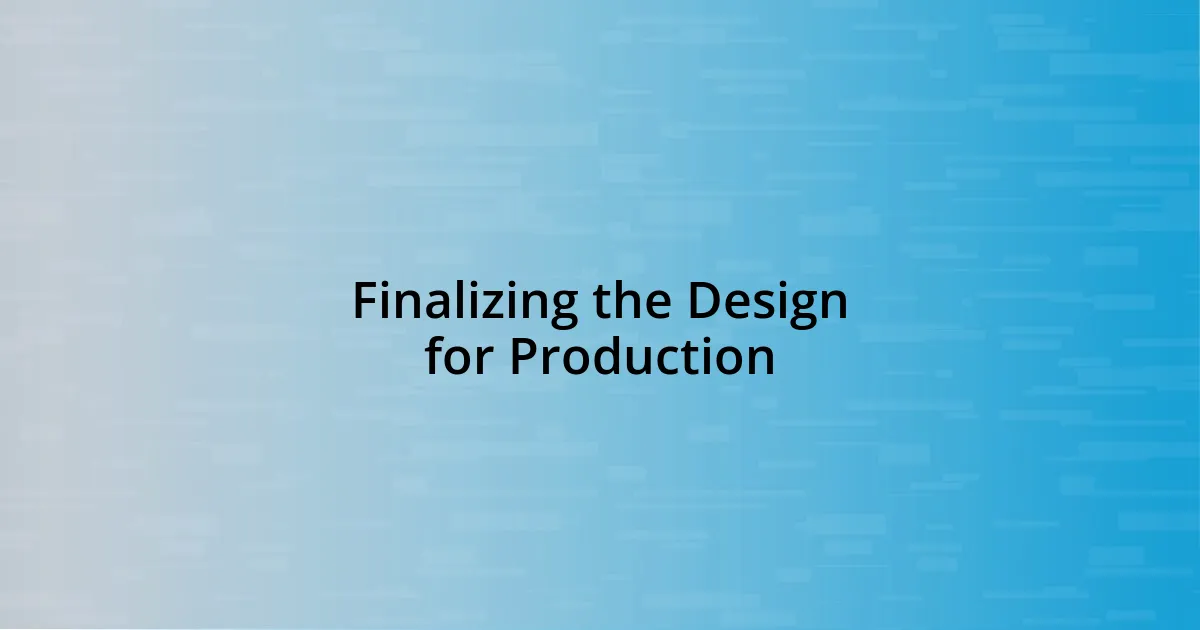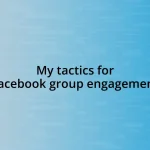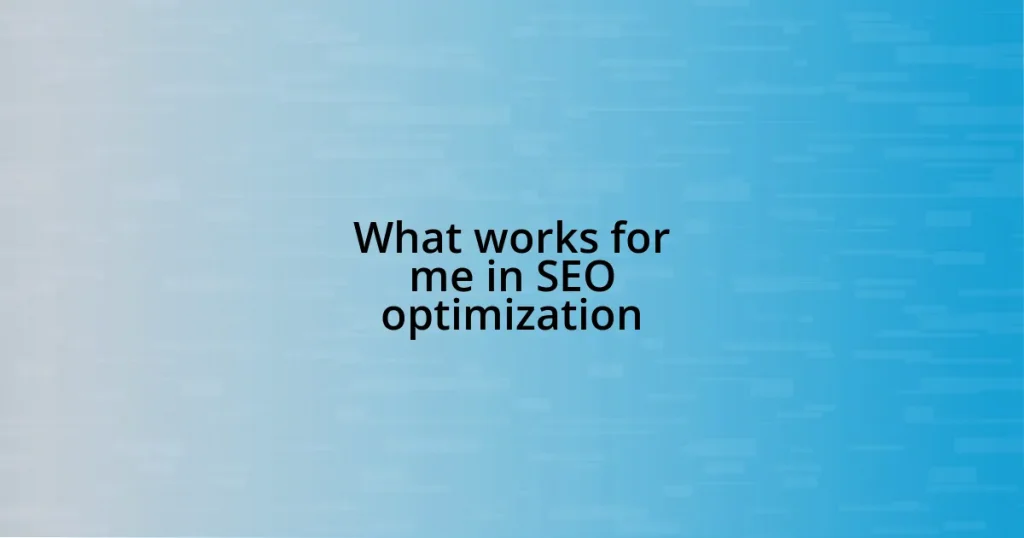Key takeaways:
- Eclipse designs blend functionality and artistry, often reflecting personal journeys of transformation and renewal.
- Researching diverse sources, including art and nature, enhances creative inspiration and emotional impact in designs.
- The iterative process, including sketching and gathering feedback, is crucial for refining designs and exploring new ideas.
- Finalizing designs requires balancing aesthetics and functionality, while ensuring emotional resonance with the audience.

Understanding Eclipse Designs
Eclipse designs are fascinating because they serve as a bridge between functionality and artistry. I remember the first time I crafted an eclipse-themed piece; the challenge of capturing the ethereal beauty of the phenomenon was exhilarating. Have you ever tried to translate a fleeting moment into a lasting design? It’s a rewarding puzzle that pushes your creativity to its limits.
When I think of eclipse designs, I envision layers—like the cosmos itself, where each layer represents a different aspect of the experience. Every detail matters, from the color choices to the textures applied. I once used a shimmering black fabric that seemed to absorb light, much like an eclipse does with the sun. Isn’t it incredible how such materials can evoke emotions and stir memories, lifting the design from a mere aesthetic to something deeply personal?
Engaging with eclipse designs also means understanding their symbolic weight. Eclipses often signify transformation and renewal—concepts that resonate profoundly with many of us. I find it exciting how a design inspired by an eclipse can represent personal journeys, as I often create pieces that reflect my own experiences of change. Have you felt the pull of transformation in your own creative work? It’s these emotional connections that truly elevate eclipse designs from simple art to meaningful narratives.

Researching Design Inspiration
Researching design inspiration is an essential step in my creative process. I often start by immersing myself in various forms of art, literature, and even nature. For example, I once visited a planetarium, where the breathtaking visuals of stars and eclipses sparked some of my most innovative ideas. The depths of the cosmos truly ignite my imagination!
Here are some key sources I explore for inspiration:
- Artworks: I study paintings and illustrations that capture celestial themes.
- Photography: Images of eclipses can reveal color palettes and compositions I hadn’t considered before.
- Nature: Observing how light interacts with different materials outdoors helps me understand transparency and layering.
- Cultural Symbols: I delve into how various cultures interpret eclipses, which can provide intriguing twists to my designs.
By gathering insights from these diverse areas, I constantly find fresh angles for my eclipse designs, ultimately enhancing the emotional and visual impact of my creations. It’s like piecing together a cosmic puzzle!

Sketching Initial Concepts
Sketching initial concepts is where the magic truly begins for me. I love to doodle my ideas freely, letting my thoughts flow onto paper without any constraints. Just last week, I spent a rainy afternoon sketching different eclipse patterns—how the moon can gracefully slide across the sun, creating intricate silhouettes. Those moments are pure joy; it’s like my pencil dances along the page as the designs start to come alive.
I believe in the power of rough sketches. They might not look polished at first, but each line communicates something unique about the vision I have in my mind. Whenever I sketch, I often feel a connection to my childhood days, where my imagination was limitless. There’s something exhilarating about taking that unrefined idea and slowly developing it into what could be a stunning piece of art. How do you feel about that first messy stroke of creativity?
Additionally, I find that utilizing different mediums adds an exciting dimension to my sketches. Whether it’s charcoal, ink, or digital tools, each medium brings out distinct qualities in my initial concepts. Recently, I experimented with watercolor, where the colors blended beautifully, mimicking the ethereal quality of an eclipse. The fluidity of watercolors helped convey the transition of light and shadow—a vital aspect of eclipse designs. What types of mediums spark inspiration for you? I often discover that switching it up can lead to unexpected breakthroughs!
| Sketching Style | Emotion Evoked |
|---|---|
| Freeform Doodles | Joy and Excitement |
| Rough Lines | Nostalgia and Limitlessness |
| Watercolor Techniques | Fluidity and Serenity |

Selecting Color Palettes
Selecting the right color palette is a vital aspect of my design process that I approach with both joy and intentionality. I often find myself gravitating toward colors that evoke the emotions linked to eclipses—mystery, wonder, and a touch of awe. For instance, one of my most memorable projects involved a midnight blue background paired with vibrant golds and soft purples. This combination not only captured the celestial essence but also stirred a sense of tranquility. Have you ever experienced a moment where colors just felt right?
When choosing colors, I also consider the psychological impact they can have on viewers. For example, warm tones tend to ignite excitement, while cool tones can promote calmness and reflection. For a recent design, I experimented with gradients that shifted from fiery oranges to soothing blues, mirroring the transition of the sky during an eclipse. Reflecting on that project, I still remember the thrill of finding that perfect gradient—it felt like I had uncovered a hidden treasure. Isn’t it fascinating how the right hues can transform a piece entirely?
Lastly, I make use of digital tools and traditional materials to test my palettes. I enjoy creating mock-ups in software, allowing me to visualize how different colors interact in real time. A standout moment for me was when I adjusted a design’s color scheme based on feedback from peers—seeing their reactions illuminated the effectiveness of collaboration in the selection process. Do you ever seek input from others when fine-tuning your own color choices? It’s often in these discussions that I discover fresh perspectives that energize my designs!

Refining and Iterating Designs
Refining and iterating designs is where the real transformation happens for me. I take my initial sketches and colors, and I dive back in with a critical eye. For example, while working on a design centered around the eclipse, I realized that a particular swirl of colors didn’t convey the depth I wanted. I took a step back, reworked those hues, and suddenly the piece felt more alive! Have you had an experience where a small adjustment made a world of difference?
In my journey, I find the feedback loops are invaluable. When I share my work with fellow creatives, their insights often shine light on aspects I might have overlooked. One time, a colleague suggested enhancing contrast to make certain elements pop, and that simple tweak elevated the whole design. I can’t stress enough how collaboration can breathe new life into a project—what’s your take on the importance of fresh perspectives?
Lastly, I embrace the iterative process as a creative exploration, where each revision brings me closer to my vision. Sometimes, I will create multiple versions of a design, each with subtle variations. This practice not only helps in refining my work but also encourages me to explore ideas I might not have initially considered. I remember feeling particularly proud of a version that incorporated unexpected geometric patterns, which I hadn’t thought to try at first. Don’t you find that pushing the boundaries of your designs can lead to exciting revelations?

Gathering Feedback from Peers
Gathering feedback from peers is an essential step in my creative process. When I share my designs with fellow artists or friends, I often feel a flutter of excitement mixed with apprehension. I remember a time I presented a piece that I thought was finished, only to discover that a simple change, like shifting a line’s curve, could enhance the overall flow. Have you ever realized how one suggestion can spark a wave of improvement?
Listening to others’ perspectives offers me a chance to see my work through fresh eyes. I once showed a project to a mentor who pointed out subtle details I hadn’t noticed, like the balance between light and shadow. Their feedback was enlightening, leading me to refine elements that significantly elevated my design. It’s incredible how our own viewpoints can sometimes blind us to possibilities—don’t you find it valuable to have a sounding board for your ideas?
Moreover, I often encourage my peers to be candid, knowing that honesty is crucial for growth. After sharing a design concept during a brainstorming session, I witnessed a colleague’s hesitant but constructive criticism. Their input led me to rethink my approach and pushed me toward a more innovative solution. Reflecting on those moments, I appreciate the vulnerability that comes with sharing—how about you? Do you feel comfortable putting your work out there, knowing that it can lead to extraordinary breakthroughs?

Finalizing the Design for Production
Finalizing a design for production is often where the excitement meets the nitty-gritty details. I remember a project where I had to make a tough call between two layouts. While one was visually stunning, the other was far more functional. I chose functionality, realizing it would serve the audience better—have you ever faced a similar moment of decision, weighing aesthetics against practicality?
At this stage, I meticulously review every element, ensuring every line, color, and texture aligns with the vision. I once found myself revisiting a color choice that seemed fine at first but felt off during the final review. Adjusting it not only made the design more cohesive but also evoked a stronger emotional response, which is particularly important for an eclipse-themed project. Can you relate to that feeling of something just clicking into place after a slight adjustment?
Finally, I create mock-ups to visualize the design in its intended format. A vivid memory comes to mind of printing a sample for a showcase. Seeing my work transform from a digital screen into a tangible piece filled me with pride but also a hint of anxiety. I wondered if it would resonate with others the way it did with me. Have you experienced that moment of unveiling a design? It reminds me that finalizing a design is not just about the product—it’s about the journey and connection it fosters with the audience.















